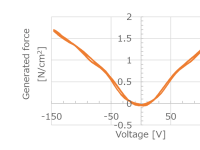As human life expectancy increases, the importance of health is increasingly recognized. Muscle deterioration due to aging not only reduces mobility but also harms mental health. Therefore, soft actuators have been studied to realize artificial muscles that support walking and standing, but none are lightweight yet easy to use.
Although electrostatic actuators are simple and lightweight devices that can emulate human muscles, they have not been used because of the risk of electric shock to the human body due to the high voltages of several 1,000 V to several 10,000 V required to generate large forces. Now, however, it may be possible to use it at a low driving voltage.
Our team is developing ferroelectric nematic liquid crystals that can be used as electrostatic actuator media. The ferroelectric material's spontaneous polarization drastically increases the generated force by a factor of 1,000, showing a linear response to the applied voltage. When filled with this material in a double-helical coil electrode device fabricated by rapid prototyping with a 3D printer, the actuator could operate at several 10 V.
Suppose a low-voltage, high-power, and lightweight actuator with a simple structure can be developed. It may find applications in the near future as an artificial muscle that helps people maintain standing and walking or as an actuator that does not use rare metals.
Electrostatic actuators consisting of a pair of electrodes generate a force whenever an electric field develops between the electrodes. By altering the shape of their electrodes and filling the gap between them with flexible, soft materials, various configurations for electrostatic actuators have been developed in which the force can emulate that of operating muscles.
In electrostatic actuators, the generated force depends on the voltage applied to their electrodes and the charges accumulated at the interface between the electrodes and the dielectric material. When ferroelectric materials are subjected to an electric field, charge separation (i.e., polarization) occurs. However, unlike conventional paraelectric materials, ferroelectrics retain their polarization even after removing the electric field, enabling them to maintain a large number of accumulated charges at a low voltage.
Ferroelectric media are superior to ordinary paraelectric media in two respects. One is that they can generate a higher force by maintaining a large polarization even at low voltage, and the other is that their voltage response is almost linear, resulting in suitable device controllability.
The ferroelectric liquid crystal generated forces 1,200 times higher than conventional paraelectric materials such as insulating oils in fundamental tests. With the ferroelectric liquid crystals and a 3D-printed double-helical coil electrode, our team demonstrated an electrostatic actuator capable of producing contraction and expansion—like muscles would—at low voltages.
These findings demonstrate that ferroelectric materials with spontaneous polarization are promising for developing electrostatic actuators suitable for artificial muscles. Our team plans to optimize the viscoelasticity of the liquid crystal material to further improve the electrostatic actuator's operation.
Video
Voting
-
ABOUT THE ENTRANT
- Name:Suzushi Nishimrua
- Type of entry:teamTeam members:
- Satoshi Masuyama
- Genichiro Shimizu
- Chun-Yi Chen
- Taku Ichibayashi
- Junji Watanabe
- Gosuke Washino
- Software used for this entry:Fusion 360
- Patent status:pending









